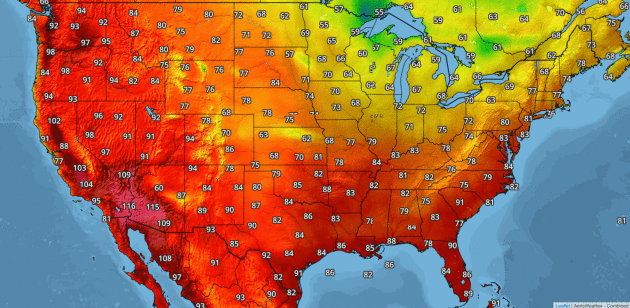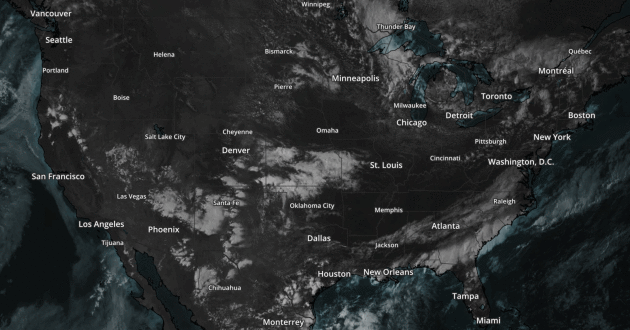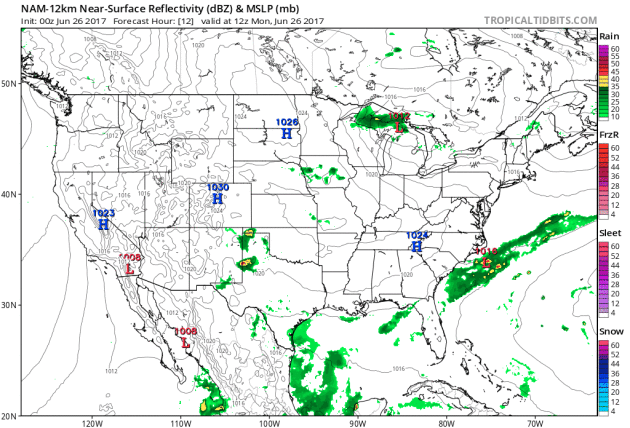69 F. Twin Cities maximum temperature on Sunday.
82 F. average high on June 25.
96 F. high on June 25, 2016.
June 26, 1982: Cold air moves into northern Minnesota. Kulger Township dips to 31 degrees. Duluth registers 36.

Enjoy the Free A/C - July Heat Wave Brewing
Definition of an optimist? Minnesotan with a pool or a convertible. Summers at this latitude remind me of my high school girlfriend. Short and cruel. 12 summer weekends to get it right, and people take it personally when the weather doesn't work out as advertised - or live up to their lofty expectations.
And with a June like this who needs October? We got off to a warm start, but Canada has retaliated with a silent invasion, and the natives are restless. Today looks like a step in the right direction: blue sky and 70 degrees. Tuesday should be summer-ish but heavy showers and T-storms return Wednesday.
Models bring another clipper-like disturbance into Minnesota late week, sparking random lines of T-storms Friday and Saturday, but probably no all-day washouts. ECMWF guidance now hints at a nicer Sunday, with more marauding bands of storms Monday as a hot front approaches.
I see a significant pattern shift ahead. The European model hints at 90F on the 4th, with a string of 90s the second week of July, as a heat-pump high stalls over the Plains.
I'd bet my best Tater-Tot Hotdish we'll soon look back fondly on these cool days. Careful what you wish for.

The Good 'Ol Days. Yes, I know. It's too cool for the lake. I feel your pain - there were whitecaps on my lake too on Saturday; only the brave and foolish were in the water. This cool spell isn't sustainable. The sun is too high in the sky - there's too much overheated air over the southern USA just waiting to surge north. At some point it will warm up. Probably overnight. Like turning on a light switch. Might I recommend that you embrace the comfortable readings, because within 1-2 weeks young and old alike will be muttering about the heat and humidity. Wait for it.
* Perceptive blog readers (and most of you are) will notice that this photo wasn't taken in Minnesota or Wisconsin yesterday. I snapped this in Clearwater Beach, Florida Sunday. The high was a sauna-like 93F and the water temperature was 88F. Bath water. You step outside your car or hotel and you instantly begin to sweat. This kind of heat may be coming to Minnesota by the second week of July.


Summary of the Great Southwest U.S. Heat Wave of 2017. I'm feeling better about our cold fronts. Dr. Jeff Masters provides perspective at Weather Underground: "The great Southwest U.S. heat wave of 2017 is gradually diminishing, but it has left behind hundreds of smashed heat records, including at least four all-time hottest temperature marks for major stations. According to wunderground weather historian Christopher C. Burt, this week’s event has been the most intense heat wave yet recorded to affect the Southwest so early in the summer, coming about a week earlier than the previous great June heat waves that have affected the Southwest, like those of 2013, 1990 and 1994.
All-time hottest temperatures tied or broken during the heat wave:
Las Vegas, NV: 117° on June 20, tied the all-time record for the airport, which has a Period of Record (POR) back to 1937. However, there was a 118° reading measured by the official USWB COOP site on July 26, 1931.Needles, CA: 125° on June 20, tied the all-time record. 126° was attained for a minute or two at one point, but not the 5-minute period needed to be deemed official. Previously, 125° was measured on June 20, 2016, and on July 17, 2005. POR: back to 1940..."
Photo credit: Brett Dzadik. "A tornado rips through the parking lot of a Home Depot on Route 9 in Howell, NJ on Saturday morning."
Prince Was a Secret Patron of Solar Power. Bloomberg explains how Prince focused his money and passion on renewable energy: "Before his abrupt death a year ago, the pop musician Prince made an investment in green energy that’s now helping solar start-ups weather an assault from President Donald Trump. It started with a conversation in 2011 between Prince and his friend Van Jones, a CNN commentator and California human rights agitator and onetime green-jobs adviser to President Barack Obama. “He asked, ‘If I have a quarter-million dollars, what can I do with it?’” Jones recalled in an interview. “My wife said he should put solar panels all over Oakland.” That led to the creation of Powerhouse, a rare for-profit incubator dedicated to putting clean-tech entrepreneurs together with investors..."
Why Offshore Wind Farms Can't Handle the Toughest Hurricanes. A risk, and an opportunity. Here's an excerpt from PBS NewsHour: "Offshore wind developments are rapidly expanding. But most wind turbines are not built to withstand a direct hit from the strongest hurricanes, according to a new study in Geophysical Research Letters that models the worst-scenarios caused by category-5 storms. Researchers predict new offshore turbines would face hurricane wind gusts of more than 223 miles per hour — but the turbines can only manage gusts of 156 miles per hour based on current engineering standards. Part of the problem: Offshore turbine designs often draw from onshore wind turbines in Europe, where hurricane conditions are essentially nonexistent..."
Photo credit: "Heavy seas engulf Rhode Island’s Block Island wind farm, the first U.S. offshore wind warm." Photo by Energy.gov/Flickr.
Why the World Needs to Get Smarter About Water Consumption. The author of a story at Eco-Business explains that in a world where 6 billion people will live in cities by 2045 we need to get a lot smarter about how we manage our most precious natural resource: "In 1900, just 15 per cent of the world’s population lived in cities. Now that proportion is over 50 per cent, which is a lot of people. In fact, it means around 4 billion human beings rely on urban infrastructure to keep them warm, mobile and clean. Technology helps with this of course. Digital sensors, smart phones and smart home appliances allow for a new kind of understanding between citizens and city officials. In this so-called “smart city”, information and communication technologies (ICT) and the internet of things (IoT) are used to enhance city living. Smart cities are a major part of achieving the goal set by the United Nations of making urban environments “inclusive, safe, resilient and sustainable”...
File image: The Guardian.
Illustration credit: Justin Renteria.

Photo credit: "Steve Perlman on the Kalalau cliffs on the Hawaiian island of Kauai." (Ken Wood).
Photo credit: Sarah Scoles/WIRED.
Photo credit: William Albert Allard/National Geographic Creative. Originally published in 1965.
All Aboard Air Koryo, North Korea's Fleet of Ancient Soviet Planes. WIRED.com has a fascinating piece: "North Korea possesses the technological wherewithal to develop a nuclear bomb, launch devastating cyberattacks,
and even hurl rockets toward its enemies. Yet it can't manage to put
together an airline that isn't heavily stocked with Cold War-era Russian
airliners. That said, the Air Koryo fleet is pretty cool in a retro
kind of way, and a passionate band of aviation buffs happily spend their
days taking joyrides. “They’re beautiful,” says Arthur Mebius. “These planes still have the original interiors they were delivered with...”
Photo credit: "A pilot removes the engine covers of a Tupolev Tu-154." Arthur Mebius.
TODAY: Partly sunny, nice. Winds: NW 10-15. High: 71
MONDAY NIGHT: Clear and cool. Low: 53
TUESDAY: Lukewarm sun with a stiff breeze. Winds: S 10-20+ High: 77
WEDNESDAY: Heavy showers and T-storms likely. Winds: S 10-15. Wake-up: 61. High: 73
THURSDAY: Peeks of sun, a drier day statewide. Winds: NE 5-10. Wake-up: 63. High: 76
FRIDAY: Unsettled, showers and T-storms. Winds: NW 8-13. Wake-up: 60. High: 70
SATURDAY: Sunny start, few PM T-storms. Winds: NW 10-15. Wake-up: 58. High: 75
SUNDAY: More sun, a better lake day? Winds: W 5-10. Wake-up: 55. High: 78
TUESDAY: Lukewarm sun with a stiff breeze. Winds: S 10-20+ High: 77
WEDNESDAY: Heavy showers and T-storms likely. Winds: S 10-15. Wake-up: 61. High: 73
THURSDAY: Peeks of sun, a drier day statewide. Winds: NE 5-10. Wake-up: 63. High: 76
FRIDAY: Unsettled, showers and T-storms. Winds: NW 8-13. Wake-up: 60. High: 70
SATURDAY: Sunny start, few PM T-storms. Winds: NW 10-15. Wake-up: 58. High: 75
SUNDAY: More sun, a better lake day? Winds: W 5-10. Wake-up: 55. High: 78
Climate Stories....
"Call Me Crazy, but Conservatives Should Probably Conserve". Clean air, clean water and a stable climate shouldn't be a partisan issue. My thanks to everyone who stopped by Salem Lutheran Church in Deerwood, Minnesota Friday afternoon. Here's an excerpt from The Brainerd Dispatch: "...His realization that climate change was happening came not from Al Gore, but simply observing the new extremes of weather, Douglas said. It made sense to him both from the capitalist and Christian perspectives to work to combat climate change. Teddy Roosevelt launched the National Park Service, and Richard Nixon, the Environmental Protection Agency. Ronald Reagan once said the government had a duty to protect against the environmental damages of industrial development, Douglas pointed out. Douglas said it was inherent that Republican ideals align with environmental protection. "Call me crazy, but I think conservatives should probably conserve," he said. "Otherwise, change your name..."
Photo credit: "Longtime TV meteorologist Paul Douglas speaks on climate change science Friday inside the sanctuary at Salem Lutheran Church in Deerwood, as part of the Lakes Area Unlimited Learning lecture series." Zach Kayser/Brainerd Dispatch.
From Heatwaves to Hurricanes, Floods to Famine: Seven Climate Change Hotspots. The Guardian takes a look at where the symptoms of a rapidly changing climate may have the most immediate implications: "...The evidence for the onset of climate change is compelling. But who and where is it hitting the hardest? How fast will it come to Africa, or the US? What will be its impact on tropical cities, forests or farming? On the poor, or the old? When it comes to details, much is uncertain. Mapping the world’s climate hotspots and identifying where the impacts will be the greatest is increasingly important for governments, advocacy groups and others who need to prioritise resources, set goals and adapt to a warming world. But lack of data and different priorities make it hard. Should scientists pinpoint the places most likely to see faster than average warming or wetter winters, or should they combine expected physical changes with countries’ vulnerability? Some hot-spot models use population data. Others seek to portray the impacts of a warming world on water resources or megacities..."
No comments:
Post a Comment